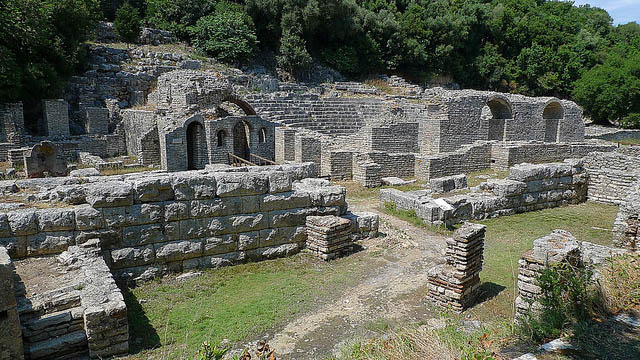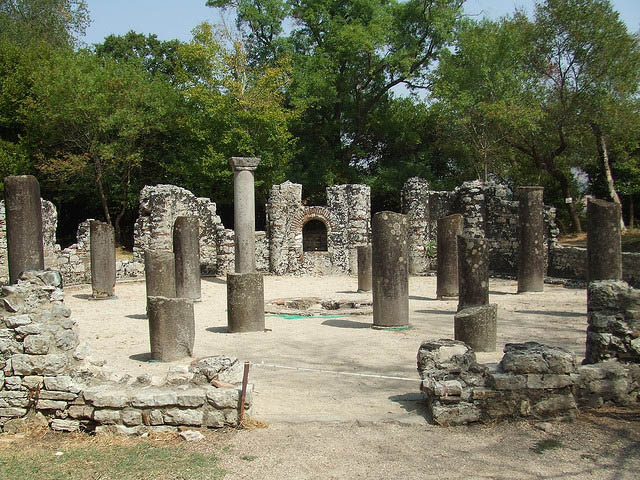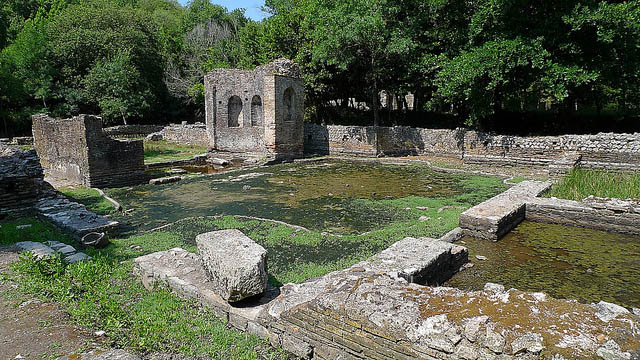Inhabited since prehistoric times, Butrint has been the site of a Greek colony, a Roman city and a bishopric. Following a period of prosperity under Byzantine administration, then a brief occupation by the Venetians, the city was abandoned in the late Middle Ages after marshes formed in the area. The present archaeological site is a repository of ruins representing each period in the city’s development.
 |
| Venetian Tower Butrint |
The city of Butrint is one of the fragments which form the fabric of Albania's ancient cultural landscape. Nestling in the highlands in the far south of the country and surrounded by dense vegetation, Butrint was linked to the Mediterranean by the Vivari canal, which runs from the Butrint Lake to the Ionian Sea.
 |
| The theatre, Butrin |
The settlement became an important stop along the merchant trade routes and reached the height of its glory in the 4th century BC as one of the major maritime and commercial centres of the ancient world. The sight of the fortifications alone, which date from the 6th century BC, evokes the military and economic potential of the city at the time. The hill on which the acropolis stands is encircled by a wall built from huge stone blocks. The amphitheatre, dating from the 3rd century BC, bears witness to the cultural riches of the city: the stone banks of seating, of which 23 rows have been preserved, would have held an audience of 1,500. The theatre is situated at the foot of the acropolis, close by two temples, one of which is dedicated to Asclepios, the Greek god of medicine, who was worshipped by the city's inhabitants.
 |
| The lion gate, north side of Butrint, |
Excavations have brought the light to many objects - plates, vases, ceramic candlesticks - as well as sculptures including a remarkable 'Goddess of Butrint' which seems to completely embody, in the perfection of its features, the Greek ideal of physical beauty.
 |
| The sanctuary of Asclepius, Butrint |
Under the rule of the Romans the city was to fall slowly into decay. In spite of this, three monumental fountains, three public baths, a gymnasium decorated with mosaics, and especially the aqueduct constructed during the reign of Augustus, prove that the site was not completely abandoned.
 |
| The standing stones of Asclepius, Butrint |
In the palaeo-Christian period, two basilicas and a baptistry were built; its later medieval history was turbulent as the town was involved, first, in the power struggles between Byzantium and successive Norman, Angevin and Venetian states and then in the conflict between Venice and the Ottoman Turks. Subterranean infiltration of water forced the inhabitants to flee, and the abandoned city was covered by mud and vegetation.
 |
| The 'New' Roman Town, Butrint, |
It was not until the beginning of the 20th century that systematic excavations were carried out by Italian archaeologists; following the liberation of Albania in 1944, Albanian archaeologists undertook more ambitious excavations. The mud and vegetation that covered Butrint had protected it from the natural and human ravages of time, and the entire city was revealed almost intact. Key areas of excavation include a late antique palatial dwelling known as the Triconch Palace, the spectacular late antiquity baptistry, and a Roman villa and associated late antiquity church at Diaporit.

























Say something! Leave a Reply ?